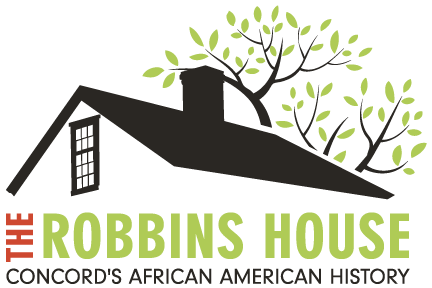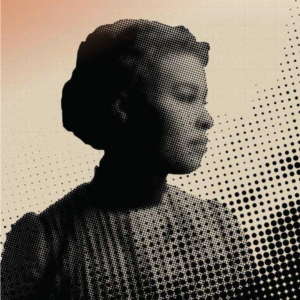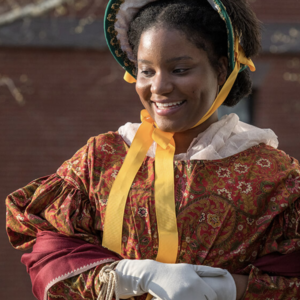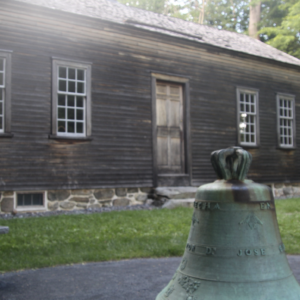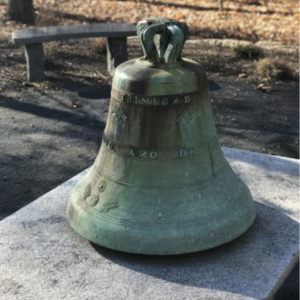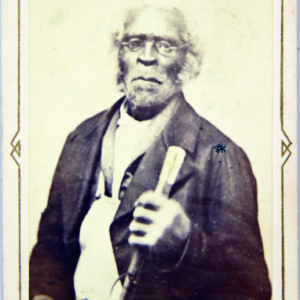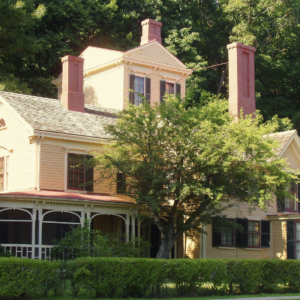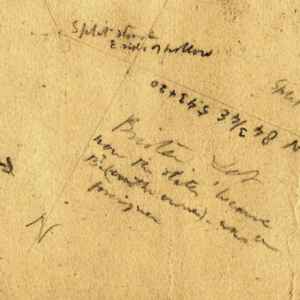The following audio files correspond to linked areas on the Self-Guided Walking Tour
The audio content was created and recorded under the leadership of CCHS student Grady Flinn. He also created a plaque for the Brister Freeman Family Home Site, and the Cuba Plantation Bell.
Robbins House Audio Tour
Ellen Garrison: An Upstander for Justice, narrated by Obi Akubude
Audio PlayerEllen Garrison: An Upstander for Justice
Ellen Garrison grew up in the Robbins House and was a Freedmen’s School teacher in the South as part of the American Missionary Association1. In 1866, after facing racial discrimination in a Baltimore train station, Ellen was determined to seek justice. She filed a lawsuit against the railroad after she and a fellow schoolteacher were “forcibly ejected” from a waiting room, and the case became a legal test of the Civil Rights Act of 1866. On these events, Ellen wrote several letters to her colleagues. These are some of the things she wrote2:
“This is the first time that I have felt it to be my duty to make any serious complaint but an outrage has just occurred which demands attention. It was nothing less than the forcible ejection of myself and Miss Anderson from the ladies’ sitting room at the depot of the Philadelphia Baltimore & Washington Railroad in the city of Baltimore…”
“[we] took our seats in the ladies’ room from which we were thrown out – literally thrown. We came up in [the] next train with the impression that we had been outrageously abused, and insulted and hurt also, as it was done in a very rough manner. I feel the effects of it still.”
“We were injured in our persons as well as our feelings for it was with no gentle hand that we were assisted from that room…
I made up my mind to make a complaint to the Superintendent of the Freedman’s Bureau General Stannard whose headquarters are at Baltimore. I did so, in person. He said that it ought to be attended to. The General also told me that he would do all in his power. He also says he wishes to ascertain whether respectable people have rights which are to be respected. Thus you see it will be a question of much importance. It will not benefit us merely as individuals but it will be a stand point for others.
…
It is different from the past. We can now give evidence.”
And thus, Ellen took legal action to question the strength of the new law.
“[The] people of Baltimore came to our aid in a very unexpected manner. They said they would assist us with their money to continue the case and by no means to give in but test it and find out if we have civil rights or not. They said it concerned them all.
…
We did not once lose sight of our position, but maintained our dignity.
…
we contend against outrage and oppression wherever we find it, firmly standing and giving away for the rudest shocks”4
Unfortunately, Ellen’s suit was dismissed. Throughout the Reconstruction Period, southern courts and lawmakers failed to duly uphold the civil protections promised to African Americans by the Civil Rights Act of 1866 (and later, the 14th Amendment). Even though the lawsuit didn’t see the success Ellen and the people of Baltimore had hoped for, her dedication to seeking the same protections that activists would fight for in the coming decades is no less significant, and her story is an early landmark in a huge movement that continues today2.
Thank you for educating yourself about Concord’s African-American and anti-slavery history.
Works Cited:
1 Concord Museum. “The Letters of Ellen Garrison.” YouTube, YouTube Video, 1 June 2021, www.youtube.com/watch?v=rTCUOj3LEo0. Accessed 25 May 2023.
2 “Ellen Garrison Exhibit – the Robbins House.” The Robbins House, 7 Mar. 2019, robbinshouse.org/projects/ellen-garrison-exhibit/. Accessed 25 May 2023.
3 Forbes, Ella. African American Women during the Civil War. Routledge, 2013.
4 Quotes.docx, Ellen. “Copy of Ellen Quotes.docx.” Google Docs, 2019, docs.google.com/document/d/11s4GQrii-ua8pOGG3o31zQvMQ1_IQecc/edit. Accessed 25 May 2023.
The Life of Ellen Garrison, narrated by Autumn Mendonca
Audio PlayerThe Life of Ellen Garrison
For the entirety of her childhood, Ellen Garrison would call the Robbins House in Concord, Massachusetts home. Her mother, Susan Garrison, was one of the first residents of the house, and Ellen Garrison would return to Concord each summer during her adult life. Having been born in 1823, she grew up during the Antebellum Period, a time that saw a leap in the push for abolition. Her mother and father were very active in the town of Concord throughout her early life, taking part in local activities. Susan was a founding member of the Concord Female Antislavery Society, hosting their second meeting in her home. In fact, Ellen’s engagement in the questions of Civil Rights extended beyond those of African-Americans. Her signature appeared alongside 200 others on a petition protesting the government’s treatment of the Cherokee. She attended Concord’s public schools and earned several awards recognizing her academic prowess2. As an adult, Garrison became a Freedmen’s School teacher in the South as part of the American Missionary Association1.
ANTISLAVERY ACTIVIST
“…Early on, she learned about racial discrimination, and followed in her mother’s footsteps as an antislavery activist. At 12, she marched in a Concord parade hand-in-hand with her white schoolmate ‘beneath the gaze of curiosity, surprise, ridicule and admiration.’ Ellen signed many petitions as a way to make her voice heard.
After the Civil War, Ellen taught newly freed people during Reconstruction. Her application explained, ‘I have a great desire to go and labor among the freedmen of the South. I think it is our duty as a people to spend our lives in trying to elevate our own race. Who can feel for us if we do not feel for ourselves?’
TRUE TO HER CALLING
In the hostility of the post-Reconstruction South, Ellen’s teaching post was defunded. She followed Kansas “Exodusters” in 1879 to again teach newly freed people. After a decade in Kansas as a teacher, Homestead farmer’s wife, and stepmother, Ellen moved with her later family to an egalitarian, antislavery community in Pasadena, California, where she is buried with other antislavery activists.”3
Thank you for educating yourself about Concord’s African-American and anti-slavery history.
Works Cited
1 Concord Museum. “The Letters of Ellen Garrison.” YouTube, YouTube Video, 1 June 2021, www.youtube.com/watch?v=rTCUOj3LEo0. Accessed 25 May 2023.
2 “Ellen Garrison Exhibit – the Robbins House.” The Robbins House, 7 Mar. 2019, robbinshouse.org/projects/ellen-garrison-exhibit/. Accessed 25 May 2023.
3 “Ellen Garrison – the Robbins House.” The Robbins House, 12 June 2020, robbinshouse.org/story/ellen-garrison-jackson/. Accessed 26 May 2023.
The Robbins House, narrated by Wilbur Moffitt
Audio PlayerThe Robbins House
Pathways to Independence
This 544-square-foot house, built in the early 1820s, was originally located on an isolated farm overlooking the Great Meadows along the Concord River. The first two families who lived here were descendants of Caesar Robbins, a Revolutionary War Patriot. In 1823, Caesar’s son Peter Robbins purchased the new two-room house and over thirteen acres for $260. Peter and his wife Fatima resided in the west side of the house; Peter’s sister, Susan, her husband Jack Garrison, and their children occupied the east side. Peter Hutchinson, Fatima’s relative, bought the house in 1852. He and his large family were the last to live in this house on the farm.
Power of Self-Determination
In 2010, the house was saved from demolition, moved here, and restored. Today, The Robbins House embodies the determination of Caesar Robbins and his family to support themselves on the land and to shape their own destinies as free men and women—and serves to inspire conversations about race and social justice issues1.
Want to engage in Concord’s African-American and antislavery history? Visit The Robbins House today, experience state-of-the-art exhibits, and learn about Concord’s lesser-known early inhabitants from knowledgeable and passionate interpreters. The Robbins House was once home to several generations of Concord’s free African-Americans; today, we are lucky enough to use the space within its walls to learn their stories and better understand our history.
Thank you for educating yourself about Concord’s African-American and anti-slavery history.
Works Cited
1 “Learn the History – the Robbins House.” The Robbins House, 12 Apr. 2021, robbinshouse.org/learn/. Accessed 5 Sept. 2023.
The Cuba Plantation Bell, narrated by Grady Flinn
Audio PlayerThe Cuba Plantation Bell – Plantation Artifact
This Cuba Plantation Bell was made in 1832 in the town of Trinidad, Cuba. Its specific whereabouts for nearly a century are unknown, but in 1926 it was gifted to Belmont Hill School by the General Manager of the Trinidad Sugar Company1.
KIDNAPPED AND EXPLOITED
Historians estimate that roughly 7% of all enslaved Africans brought to the Americas in the 18th and 19th centuries were transported to Cuba to work on the island’s many sugar and coffee plantations. That’s about 600 to 900 thousand people2. Cuba attracted an enormous amount of trade in human cargo; despite bans on the slave trade from the United States, Great Britain, and Spain, the island’s illicit trade of humans continued for decades until 1867, when the last documented ship carrying enslaved Africans landed in Cuba3.
DISCOVERING THE BELL’S HISTORY
In 2018, student historians at Belmont Hill School researched school archives as well as academic scholarship on Cuban slavery to determine how the bell had been used. Had this bell called free people to church, or enslaved people to labor? Its intended use can be discerned from the way in which it was mounted at the school. The December 1925 issue of the school paper The Sextant notes that, once it arrived, the bell would be “mounted on scaffolding as is the custom in Cuba.”2 Syracuse University historian Theresa A. Singleton has observed that bells mounted on a “simple frame, were used on plantations everywhere to structure the daily routine of slave workers.” 4
Taken together, these two pieces of evidence persuaded the student scholars and school administrators that this bell had indeed contributed to Cuba’s violent slave labor regime. Following a vote by the school’s Board of Trustees, the bell was removed from campus in late summer 2020.
The Cuba Plantation Bell and The Robbins House symbolize the two poles of this racial wealth gap. The bell represents the systematic theft of wealth – and of life – through forced labor. The house represents the dream of home ownership, of being able to invest one’s earnings in such a way that wealth can be passed along to the next generation.
Thank you for educating yourself about Concord’s African-American and anti-slavery history.
Works Cited
1 Moody’s Manual of Railroads & Corporation Securities,
2 The Sextant Volume III, No. 1 (Belmont Hill School, Christmas 1925),
3 Cuba and the United States in the Atlantic Slave Trade (1789–1820)” Tomich, Dale. “World Slavery and Caribbean Capitalism: The Cuban Sugar Industry, 1760-1868” Theory & Society, Vol. 20, No. 3 (June 1991), 304.
4 Theresa A. Singleton, “Nineteenth-Century Built Landscape of Plantation Slavery in Comparative Perspective,” Chapter 5 in The Archaeology of Slavery: A Comparative Approach to Captivity and Coercion (Southern Illinois University Press, 2015).
5 The Robbins House, “The Cuba Plantation Bell,” Brochure.
Peter Hutchinson, The Robbins House’s Final Resident, narrated by by Celeste Pinto
Audio PlayerPeter Hutchinson, The Robbins House’s Final Resident
Peter Hutchinson was an African-American Concordian who lived from 1799 to 1882. Peter married Nancy Dager at the First African Baptist Church in Boston, with whom she had six children. Peter and his large family were the last African-Americans to own The Robbins House, and they lived there from 1852 to 18681.
Prizewinning Work
Described by another farmer as “the ablest common laborer I have ever known,” Peter constructed buildings, slaughtered livestock, and sold pigs to other farmers. He won first prize in the plowing contest at the 1835 Middlesex agricultural fair. Peter signed petitions opposing railroad discrimination and the 1850 Fugitive Slave Law. Peter “had more local knowledge of wood lots and meadow bounds than any man in town,” according to J.S. Keyes. During his time in the Robbins house, the farm lane became known as Peter’s Path, a spring was known as Peter’s Spring, and the woods nearby were called Peter’s Woods. Fifty years after his death, a local firewood business was named the Peter Hutchinson Company in his honor4.
Peter’s Connections to Concord’s Pantheon of Authors
Emerson’s poems “Peter’s Field” and “Dirge” were set on the farm overlooking the Great Meadows during the years Peter Hutchinson owned it. Thoreau expressed respect for Peter Hutchinson’s knowledge of Concord’s woods, fields, and wildlife throughout his journals.
In 2013, The Robbins House and the Friends of Sleepy Hollow provided a marker for Peter Hutchinson and his family at Sleepy Hollow Cemetery
Sending Off The Robbins House
After Peter, the house saw an extensive history. It passed through many hands, was situated on two more properties, and was even rented out for a period of time. Today, it serves to inspire conversations about race and social justice issues, using its inhabitants, such as Peter, to better understand the ways in which the first generations of free Concord African Americans pursued independence and contributed to the antislavery movement and abolitionist causes2,3.
Thank you for educating yourself about Concord’s African-American and anti-slavery history.
Works Cited
1 “Hutchinson Family Grave Marker – the Robbins House.” The Robbins House, 7 Mar. 2019, robbinshouse.org/projects/hutchinson-family-grave-marker/. Accessed 7 Sept. 2023.
2 “Learn the History – the Robbins House.” The Robbins House, 12 Apr. 2021, robbinshouse.org/learn/. Accessed 7 Sept. 2023.
3 Forbes, Anne, and Lawrence Sorli. The Robbins House Historic Structure Report. Aug. 2017.
4 “Peter Hutchinson – the Robbins House.” The Robbins House, 12 June 2020, robbinshouse.org/story/peter-hutchinson/. Accessed 7 Sept. 2023.
John “Jack” Garrison; Racial Inequality Then and Now, narrated by Andrew K Nyamekye
Audio PlayerJohn “Jack” Garrison; Racial Inequality Then and Now
40 Years Enslaved, Forever a Fugitive
By 1810, John “Jack” Garrison had fled his enslaved life in New Jersey for freedom in Concord. Here he found work as a woodcutter and day laborer for Concord residents. In 1812 he married Caesar Robbins’ daughter, Susan, one of the first of The Robbins House’s residents. Under the threat of both the 1793 and 1850 federal fugitive slave laws, Jack was vulnerable to capture for the rest of his life.
New Jersey’s Gradual Emancipation
In February 1804, New Jersey passed a law providing for the “gradual emancipation of slaves” and became the last Northern state to begin the process of ending slavery within its borders. The 1804 act provided that children of enslaved people born after July 4, 1804 would be freed when they reached the age of 21 for women and the age of 25 for men. People held in bondage who had been born before these laws were passed remained enslaved until 1846 when they were considered indentured servants who were “apprenticed for life”. Slavery did not truly end in New Jersey until it was ended nationally in 1865 after the Civil War and the passage of the Thirteenth Amendment to the US Constitution.
Signed with an “X”
Slavery denied Jack an education; he signed his name with an “X” throughout his life, but his surviving children went to Concord schools and were “literate and good students.” In his later years, Jack lived on and off at Concord’s poor farm until his son John could afford to remove him. Well into his 60s, Jack walked about town “with his saw-horse over his shoulder and his saw on his arm.” He lived to be about 92 years old1.
Symbol of a Cause
As the oldest person in town, Jack received a walking stick from the Town of Concord, and the Concord Female Antislavery Society printed his image on a calling card used to raise awareness of the antislavery movement. Jack’s and his son John’s photos are the only known images of early Concord African-Americans1; early symbols of the fight for freedom.
Thank you for educating yourself about Concord’s African-American and anti-slavery history.
Works Cited
1 “Jack Garrison – the Robbins House.” The Robbins House, 12 June 2020, robbinshouse.org/story/jack-garrison/. Accessed 3 Sept. 2023.
2 “John Garrison Right to Equal Employment Conclusion” The Robbins House, 2019, Accessed 3 Sept. 2023.
George Washington Dugan, Concord’s Unrecognized War Veteran, narrated by Lilly Caulfield
Audio PlayerGeorge Washington Dugan, Concord’s Unrecognized War Veteran
George Washington Dugan was born in Concord in 1819 and worked as a farmer and as a hostler taking care of the horses at the Middlesex Hotel. He owned a house and nine acres of land at a time when about 60% of Concord male taxpayers didn’t own either. His father escaped slavery in Virginia, and his mother was from nearby Acton3. His father introduced the rye cradle and grafting apples to the Concord farming community4.
In his 40s, after his spouse passed away, George chose to leave home and serve in The Massachusetts 54th, the first all-Black regiment of the Union Army. The formation of George’s regiment was a difficult topic to push. Many questioned Black men’s ability to fight (women were not officially allowed to join the military for nearly two more centuries), and some argued that the subject was merely one of too much controversy to come to fruition. The compromise that resulted was to limit Black applicants to enlistment, while white men were given roles as commissioned officers. Racial discrimination was unfortunately a challenge that George and many of his comrades faced during their service, and it didn’t end at limitations on rank. In comparison to white soldiers in their Army, Black patriots earned very little money; George was not paid a dollar for his time in the 54th.
At the famous Second Battle of Fort Wagner in 1863, a conflict that inspired many more African-Americans to enlist in the Union Army, George Washington Dugan was killed in action during his first year in the Regiment5. This battle served as a standpoint for others; it, along with the Emancipation Proclamation, suddenly caused an extreme increase in Union enlistment, the key turning point that allowed Northerners to defeat the rebellious slaveholders of the South1,6.
Forgotten and Excluded
George gave his life for the Union, but his hometown failed to add his name to its Civil War Monument. It wasn’t until over a century and a half after his sacrifice at Fort Wagner that Concord voted to have Dugan’s name etched into the obelisk in the town square, joining dozens of those of other Concordians who gave their lives to the Union cause. At the time of recording this excerpt, the plaque on the Civil War Monument is yet to be updated, but funds are now being raised to change this2. This addition to the monument is part of a larger effort in the town to honor George’s sacrifice.
Dugan’s body was never returned to Concord, but a cenotaph was placed in the town’s Sleepy Hollow Cemetery during a formal dedication honoring his memory with units from across the country in summer, 2023, on the 160th anniversary of his sacrifice1.
Acknowledgement 160 Years in the Making
As Joe Palumbo, a Robbins House interpreter and the chair of the committee creating events and celebrations around the 250th Anniversary of the start of the American Revolution puts it, “For many years the town remained focused on ‘minutemen and muskets’ and the literary greats that make up the ‘Concord Pantheon’. Busts and paintings of Emerson, Thoreau, and Hawthorne abound throughout the town
…
Slowly this is starting to change
…
This memorial to George allows for public visibility and exposure to learn about and honor a history that may be new to some but is essential for them and their understanding of Concord’s role in securing freedom for all people.”
Works Cited
1Palumbo, Joe. “Honoring the Sacrifice of George Washington Dugan.” Discover Concord, 14 June 2023. issuu.com, issuu.com/discoverconcordma/docs/dc.summer23web. Accessed 7 Sept. 2023.
2 Palumbo, Joe. “A Walk Along Concord’s American Mile.” Discover Concord, 14 June 2023. issuu.com, issuu.com/discoverconcordma/docs/dc.summer23web. Accessed 7 Sept. 2023.
3 “CONCORD’S 49TH FALLEN CIVIL WAR SOLDIER: “Faithful unto Death.”” Concordma.gov, Town of Concord, concordma.gov/DocumentCenter/View/34232/G-W-Dugan–articleCJ-1#:~:text=Identified%20in%20the%201908%20report,under%20Colonel%20Robert%20Gould%20Shaw. Accessed 7 Sept. 2023.
4 “Thomas and Jennie Dugan – the Robbins House.” The Robbins House, 12 June 2015, robbinshouse.org/story/thomas-and-jennie-dugan/. Accessed 7 Sept. 2023.
5 “The 54th Massachusetts and the Second Battle of Fort Wagner (U.S. National Park Service).” Nps.gov, 2023, www.nps.gov/articles/the-54th-massachusetts-and-the-second-battle-of-fort-wagner.htm#:~:text=The%2054th%20Massachusetts’%20valor,the%20duration%20of%20the%20war. Accessed 7 Sept. 2023.
6 “A Duty so Severe: Concord and the Civil War – Issuu.” Issuu, issuu, 29 Mar. 2021, issuu.com/discoverconcordma/docs/dc.spring21.final/s/11973725. Accessed 7 Sept. 2023.
Concord, Massachusetts, A Major Depot for the Underground Railroad, narrated by Nafeesa Hoda
Audio PlayerConcord, Massachusetts, A Major Depot for the Underground Railroad
Concord, Massachusetts looms large on the list of significant historical towns in the United States. The town was once home to influential activists such as Ellen Garrison, literary greats such as Louisa May Alcott, and important thinkers such as Henry D. Thoreau. Concord was the site of the legendary battle at the North Bridge that kicked off the American Revolution. One part of Concord’s history that is lesser-known than some of these others, includes its involvement in the Underground Railroad. Through decades of its existence, Concord was a major stop on the Underground Railroad, and it saw many who had escaped enslavement on their way to freedom in the Northern United States and Canada. These are some of the ways that Concordians aided fugitive enslaved people on their journey to freedom:
The Concord Depot – 90 Thoreau Street
The Fitchburg Railroad opened its route through Concord in 1844, with connections north to Vermont and Canada. The original railroad depot, close to the town center, facilitated the efforts of Concord residents to aid the escape of fugitive slaves to freedom on the “Underground Railroad.” Thoreau wrote in his Journal in 1851 about lodging self-emancipated slave Henry Williams and putting him on a train to Canada.
Colonel William Whiting House – 169 Main Street
Colonel Whiting was vice president of Massachusetts’ antislavery society and sheltered runaway enslaved people. Abolitionists William Lloyd Garrison (who published the antislavery newspaper The Liberator), Wendell Phillips, and John Brown were all guests in this house.
Thoreau-Alcott House – 255 Main Street
The entire Thoreau family was instrumental in the antislavery movement, and they housed and aided many fugitives during their journeys northward2. They moved here in August 1850, and Henry David Thoreau wrote in his Journal on 10/1/1851 about helping Henry Williams on his way to Canada.
The Wayside – 455 Lexington Rd
The “muster master” of the Concord Minutemen during the Battles of Lexington and Concord, who owned an enslaved person, lived in the Wayside. This enslaved person, who was named Casey and has also been known as Case, fought in the Revolutionary War for the colonies and returned to Concord as a free man. Later on, the Wayside was home to the Alcott family from 1845-48. According to a plaque on the property, “The Wayside sheltered two self-emancipated slaves during the winter of 1846-47 as they fled north to freedom in Canada. A young Louisa May Alcott learned firsthand lessons about slavery here that would influence her life and writing.”
Brooks House – 45 Hubbard Street
Mary Merrick Brooks, granddaughter and daughter of merchants who had once bought and sold enslaved people, was one of Concord’s leading white abolitionists. She carried antislavery petitions from door to door for neighbors to sign. She organized “ladies’ fairs” to raise money for the antislavery cause and contributed her signature “Brooks cake” to such events.
Mary Rice House – 44 Bedford Street
Mary Rice assisted in the escape of fugitive enslaved people and harbored many in her home. She helped replace John Jack’s gravestone and regularly put flowers beside it. In 1864, she gathered the signatures of 195 schoolchildren on a petition to President Lincoln, asking him to “free slave children.” Copies of this petition and Lincoln’s response now hang in Concord’s three public elementary schools.
Francis and Ann Bigelow House – 19 Sudbury Road
Shadrach Minkins, enslaved in Norfolk, Virginia, hid on a northern-bound vessel and made his way to freedom in Boston in May of 1850. Nine months later, he was seized by bounty hunters, and he became the first refugee from the South to be arrested in Boston under the 1850 Fugitive Slave Law. A crowd organized by the Boston Vigilance Committee rescued Minkins from custody at the courthouse and put him on a planned escape route, which involved a brief stop in the middle of the night at the home of blacksmith Francis Bigelow and his wife Ann. From Concord, Minkins traveled by train to Canada, where he became a restaurant owner and barber. According to Ann Bigelow, at the height of the abolitionist movement, “one fugitive slave passed through Concord each week.”1
Works Cited
1 “Self Guided Walking Tour – the Robbins House.” The Robbins House, 7 Mar. 2019, robbinshouse.org/projects/self-guided-trail-map/. Accessed 25 Sept. 2023.
2 “Antislavery in Concord | Essay 05 | Special Collections | Concord Free Public Library.” Concordlibrary.org, 2013, concordlibrary.org/special-collections/antislavery/05_essay. Accessed 30 Sept. 2023.
Brister Freeman; Strength, Black Ownership, and the Power of Names, narrated by Alex Nugent
Audio PlayerBrister Freeman; Strength, Black Ownership, and the Power of Names
Brister Freeman, born in 1744, who had been given as a wedding gift to Dr. John Cuming between the ages of five and nine, lived in captivity for the first thirty or so years of his life until he gained his freedom after fighting in the Revolutionary War1. During his service, Brister marched under Colonel John Buttrick to Saratoga in 1777 and watched British General Burgoyne surrender. Two years later, after being documented with the name Brister Cuming, he enlisted under the name Brister Freeman, announcing his newly acquired freedom.
In his later life, Brister purchased an acre of “old field” in Walden Woods with Charlestown Edes, a fellow African-American Revolutionary War soldier, and set up a two-family household2. He was the second man of African descent (after John Jack – see “John ‘Jack’ Garrison, Sr.; Racial Inequality Then and Now”) to purchase Concord land. Other formerly enslaved people followed and Walden Woods became one of three black enclaves that sprang up in Concord following gradual emancipation in Massachusetts1. Walden Woods was home to as many as fifteen formerly enslaved people and their families3.
Brister’s wife Fenda Freeman told fortunes; they had three children. He worked as a day laborer and endured frequent harassment from other residents and local officials. In one instance, Brister was locked by someone else with an angry bull in a slaughterhouse he frequented for work. Impressed by what Brister was able to accomplish in such a hostile environment, Henry David Thoreau compares him in Walden to Scipio Africanus, the great Roman general. This comparison is one of the many references to Brister Freeman that Thoreau makes in his writing. As a close neighbor, Thoreau also at one point details the path to Brister’s home from Walden Pond: “Down the road, on the right hand, on Brister’s Hill, lived Brister Freeman… there where grow still the apple trees which Brister planted and tended…”4
Brister passed away in 1822, but his burial site is neither marked nor known1. In his will, Brister left his land to a neighboring woman to avoid having it go to an unwelcome owner. Today, the land is part of the Hapgood Wright Town Forest and is stewarded by the Town of Concord Natural Resources Commission. The ditch fence Brister dug around his property to keep animals enclosed is still visible to passers-by. In commemoration of his life, The Robbins House placed a boulder marking the Freeman Family home site in 2011, and the site is also addressed by a nearby plaque1. The nearby “Brister’s Spring” and “Brister’s Hill Road” acknowledge Brister’s contributions to the Union and the Town of Concord. Recognition for Brister is copious; however, all mentions of Brister like these identify him by his first name, while other sites nearby are dedicated to important Concordians using their last names, such as Thoreau’s Cabin (these audio excerpts refer to their subjects by first name to allow them to be more personable to the listener). Between the last name he was forced to take on and the tendency because of his race to ignore his chosen last name, Brister’s story asks us to consider what the names we use for others say about the respect we accord to them.
Works Cited
1 “Brister Freeman Family Home Site – the Robbins House.” The Robbins House, 7 Mar. 2019, robbinshouse.org/projects/brister-freeman-family-home-site/. Accessed 22 Sept. 2023.
2 The Robbins House. “On Brister’s Hill with the Walden Woods Project – the Robbins House.” The Robbins House, 13 June 2018, robbinshouse.org/on-bristers-hill-with-the-walden-woods-project/. Accessed 22 Sept. 2023.
3 Lemire, Elise. Black Walden: Slavery and Its Aftermath in Concord, Massachusetts. S.L., University of Pennsylvania, 2019, p. 126.
4 Henry David Thoreau. Walden. London Vintage, 9 Aug. 1854.
Patriots of Color, narrated by Daniel Leonce
Audio PlayerPatriots of Color
When Caesar Robbins marched to war in 1776, enslaved and free people of African descent had been fighting in New England’s armies for generations. Throughout the 18th century, Black and white Yankees served shoulder-to-shoulder in the colonial wars that forged Britain’s North American empire. Patriots of color such as Caesar Robbins, the earliest proprietor of the Robbins farm, along with about 1,000 other Massachusetts men of color, capitalized on these circumstances and waged their own battles for independence.
After dismissing soldiers of African descent from the army at the end of 1775, George Washington was faced with strong protests from white officers and Black soldiers in New England, and he eventually reopened military service to free men of color. By the end of the first year of the Revolutionary War, New England’s Black soldiers had cemented their place in a system of fully racially integrated regiments. In March of 1776, Caesar Robbins, thirty-one years old at the time, served with a company of Acton men commanded by Israel Heald. Heald’s company marched from Acton to Roxbury during the American fortification of Dorchester Heights. Heald’s company also served at the North Bridge on April 19th, 1775 and it’s likely Robbins served with him there. In the summer of 1776, Robbins enlisted in a regiment that marched to Ticonderoga.
A few years later, Washington authorized the Rhode Island government to recruit a regiment of enslaved men, with a promise of freedom for all who enlisted. The regiment saw the enlistment of over two hundred formerly enslaved soldiers. During the war, New England regiments mobilized a larger proportion of Black soldiers than did all other states. By the time Caesar Robbins served his final tour of duty in 1779, nearly six percent of Massachusetts soldiers serving in the army were Black1.
John Oliver, who was Fatima Robbins (the daughter-in-law of Caesar Robbins)’s father, was a Patriot of Color born in Concord. The Acton Historical Society tells us that “John Oliver stated that around April 1778, he enlisted at Acton for three months…
[Later,] he went to serve in Cambridge”Finally, in 1780, John Oliver enlisted at Acton for six [months of] service in and around West Point. In Oliver’s pension application, Charles Handly of Acton testified that Oliver enlisted into the continental service for six months in 1780 and first marched to West Point, from there to New Jersey, and then to West Point, and then was discharged in Patterson’s Brigade2.
Enslaved people found their way into the army for different reasons. It’s true that some had no choice; their white enslavers would send them off only so they could take the enlistment bounties for themselves. However, many Black men were able to join the army to exchange their pay for freedom. Others ran away from captivity to join the army as their own declaration of freedom, often marking their new status by changing their names, like Concord’s Brister Freeman.
Whatever their path to service, these patriots were extraordinarily loyal to their cause, but they are rarely awarded the honor they deserve. In total, more than three thousand enslaved and free New Englanders of color served in the American army by the war’s end1.
Thank you for educating yourself about Concord’s African-American and anti-slavery history.
Works Cited
1 John Hannigan, The Robbins House, “Patriots of Color in Revolutionary New England (1775-1790),” Brochure.
2 “John Oliver of Acton, Revolutionary Soldier.” Acton Historical Society, 2018, www.actonhistoricalsociety.org/blog/john-oliver-of-acton-revolutionary-soldier. Accessed 1 Oct. 2023.
